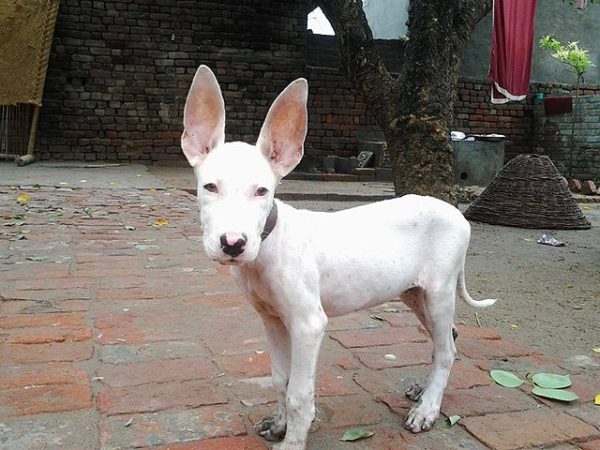
You see hear them before you see them.
And they are an astonishing sight.
Commercial trucks so heavily decorated with bells, chains, pendants, and colorful indigenous artwork and calligraphy that were one to appear on an American highway, it would stop traffic. They are “jingle trucks:”
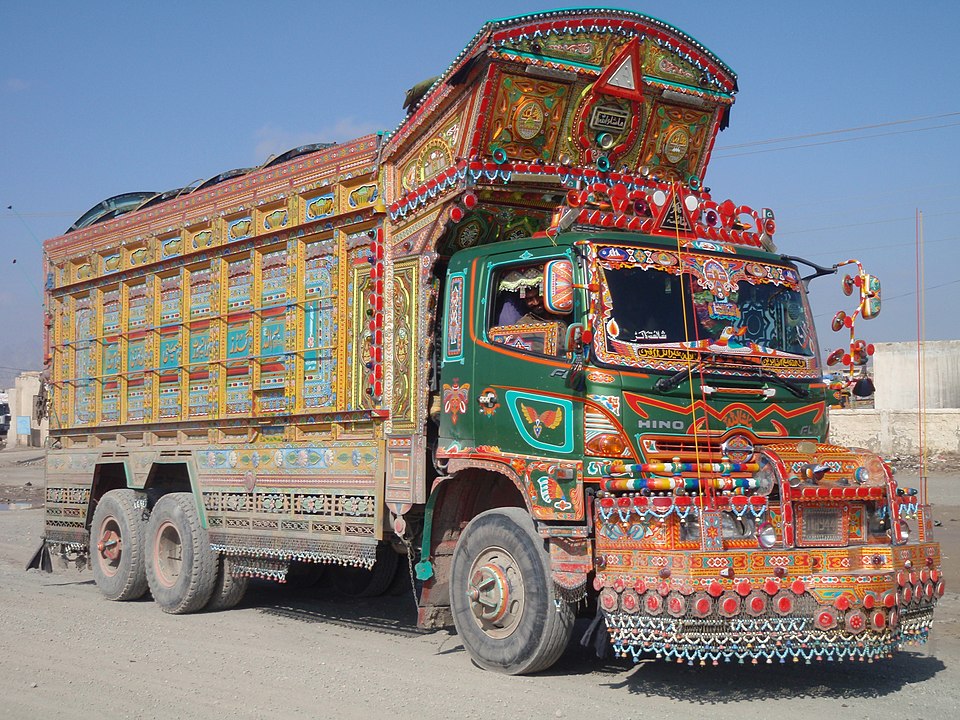
Photo of a typical Pakistani truck by Alexandros Papadopoulos from flickr.com – it appears here under Wikipedia’s ShareAlike 2.0 Generic (CC BY-SA 2.0) license
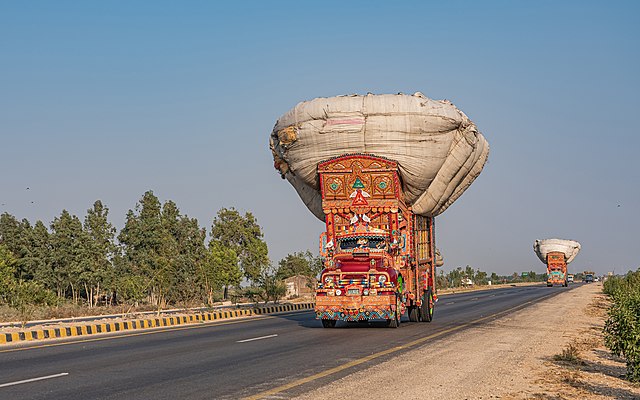
A pair of loaded jingle trucks on the N-5 National Highway between Thatta and Karachi (Sindh, Pakistan) by A.Savin. It appears here from WikiCommons

Truck art by Baharwassan is shared through the Creative Commons Attribution-Share Alike 4.0 license
The vehicles can be seen throughout South Asia, but especially in Pakistan where their origins can be traced back to the 1920s when Bedford trucks imported from England seemingly invaded the country’s streets. Companies that owned the trucks painted their logos on them so that illiterate people could understand who owned the vehicles, and what their purpose was. Over time, the logos became increasingly ornate, and the more flamboyant the designs, the better business became. Soon, companies where competing with each other.
As we mentioned earlier, truck painting spread to other South Asian countries, but in Pakistan, the art form morphed into a whole different level. An entire industry grew out of it, and today in Karachi alone, over 50,000 people are employed in studios dedicated to the craft, and truck drivers spend big money to ensure that their vehicle is nosier, more colorful, and certainly more ornate than other trucks. A basic paint job can cost $2,500 – two years salary for some drivers, and they come back for touch ups. Others have been known to spend upwards of $10,000 outfitting their ride. At least one source we found pointed out that more is spent on a truck than the driver’s home!
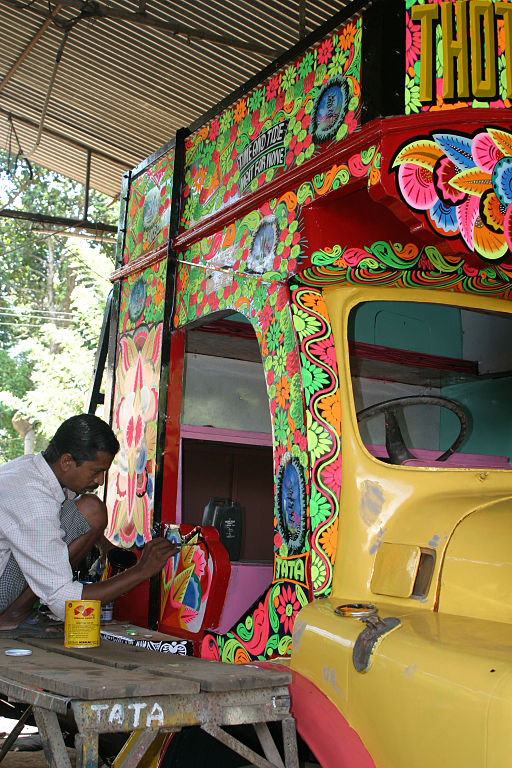
A truck being painted, photo by Brian Snelson from Hockley, Essex, England and shared under Wikicommon’s CC BY 2.0 license
The term, “jingle truck” was coined by American troops and contractors during the War in Afghanistan for the many bells strewn across the bumpers, and while they’ve become an iconic piece of cultural expression in that part of the world, they may be more than that. Truck art has its roots in Sufism, a mystical tenet of Islam that focuses on spirituality and the purification of the body. One Pakistani truck artist describes the trucks as a way to gain “religious merit,” similar to how the Sufi would decorate shrines and other religious sites. As for the truck owners, they believe that by embellishing their truck, the truck rewards them with a smooth, safe journey.
Sadly, in the view of some, the business has changed and instead of meticulously hand painting each truck, mass produced stickers are used, but there are enough purists to ensure that the artform doesn’t die out entirely.
A good article on the evolution of truck art may be read here, but right about now, you may be wondering what jingle trucks have to do with purebred dogs. We could admit that we were looking for an excuse to write about jingle trucks, but mostly we were struck that compared to the cacophony of color found in the trucks, Pakistan’s indigenous dog breeds are mostly white. They include the Bully Kutta (mostly white, but occasionally black, or white with brown spots), the Vikhan, all white, the Gull Dong, also all white, and the Gull Terrier, which we’re going to expand upon a bit below.
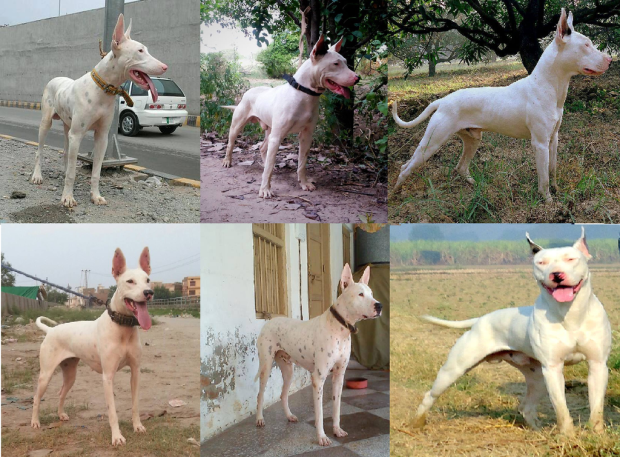
Gull Terrier photo by Robert Olivia, CC BY-SA 4.0 <https://creativecommons.org/licenses/by-sa/4.0>, via Wikimedia Commons
The Gull Terrier, as you can see in the collage above, is white, and not surprisingly, is related to the Bull Terrier which was introduced to the Punjab region of northern India and Pakistan by the British Raj.
British troops also brought English Bull Terriers to the region in the early 1900s and interbred them with native dogs. The breed’s name is derived from the Punjabi term, ‘gull,’ which means “goose,” but far from being “goosey,” Gull Terriers were used for personal protection dogs, and, sadly, sport fighting. Some “breeders” crossed the Gull Terrier with the Bully Kutta and named the results the “Gull Dong.” Gull Terriers are extremely intelligent, strong, independent, highly protective, and not for a novice owner.
Image: Gull Terrier by Robert Olivia is shared from Creative Commons Attribution-Share Alike 4.0 license
